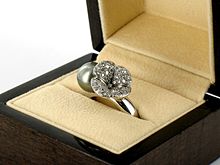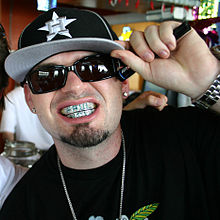- Conspicuous consumption
-
Conspicuous consumption is spending on goods and services acquired mainly for the purpose of displaying income or wealth. In the mind of a conspicuous consumer, such display serves as a means of attaining or maintaining social status.
Invidious consumption, a more specialized term, refers to consumption deliberately intended to cause envy.
Contents
History and evolution of the term
 Thorstein Veblen was a Norwegian-American sociologist and economist, and a co-founder of the institutional economics movement.
Thorstein Veblen was a Norwegian-American sociologist and economist, and a co-founder of the institutional economics movement.
The term conspicuous consumption was introduced by economist and sociologist Thorstein Veblen in his 1899 book The Theory of the Leisure Class.[1] Veblen used the term to depict the behavioral characteristic of the nouveau riche, a class emerging in the 19th century as a result of the accumulation of wealth during the Second Industrial Revolution. In this context, the application of the term should be narrowed to the elements of the upper class who use their enormous wealth to manifest social power, whether real or perceived.
With the significant improvement of living standards and the emergence of the middle class in the 20th century, the term is now broadly applied to individuals and households with expendable incomes whose consumption patterns are driven by the utility of goods to display social status rather than any intrinsic utility of such goods. In the 1920s, economists such as Paul Nystrom theorized that lifestyle changes brought on by the industrial age were inducing a "philosophy of futility" in the masses, which would increase fashionable consumption. Thus, the concept of conspicuous consumption has been discussed in the context of addictive or narcissistic behaviors induced by consumerism, the desire for immediate gratification, and hedonic expectations.
Whereas conspicuous consumption was previously thought to be something engaged in primarily by the rich, recent research by economists Kerwin Kofi Charles, Erik Hurst, and professor of finance Nikolai Roussanov points to a different understanding that this behavior is more common among poorer groups of people and in emerging economies. Displays of wealth in these groups serve to combat the impression that a person is poor, often because they are a member of a group perceived by society as poor.[2] The 1996 book The Millionaire Next Door also challenges the traditional views on conspicuous consumption by looking at the wealthiest Americans, finding that most millionaires are quite frugal and lead modest lifestyles.[3]
In the 2000s, the term conspicuous compassion was used to refer to charitable giving performed in a similar way and for similar reasons as conspicuous consumption.[4]
Distinction from other forms of consumption
Conspicuous consumption can be defined as "the act of buying a lot of things, especially expensive things that are not necessary, in a way that people notice" (Longman American Dictionary, 2000, p. 296). Additionally, a clearer meaning provided by Trigg [6] suggests that conspicuous consumption is behavior whereby an individual can display wealth through extensive leisure activities and luxury expenditure on consumption and services. Duesenberry [7] argued that an individual's conspicuous consumption depends not only on the actual level of spending but also spending compared with that of others. He emphasised the importance and effects of an individual's reference groups to their consumption patterns, and this view has been supported by various researchers.[8]
Eastman et al.[9] stated that status consumption is based on conspicuous consumption (among other contributions). To some extent the literature appears to lack clarity and possesses significant overlap in the definitions of status consumption and conspicuous consumption.[10] O'Cass and Frost[11] noted that researchers have often used status consumption and conspicuous consumption interchangeably. However, in a later study they found that these constructs are different. The discussion above suggests that there exists both ambiguity and general consensus among researchers with regard to the conspicuous consumption construct.
As observed by Mason,[12] there is no doubt that the classical general theories of consumer decision processes do not happily accommodate conspicuous consumption, a fact which cannot be considered surprising in view of the exceptional atypical nature of such behaviour. Whilst there is considerable recognition of the importance of the consumers' social psychological environment, status-directed consumption has been neglected primarily because of the necessity to accept two fundamental assumptions when developing a general theory. First, that while both "rational" (economic) and "irrational" (psychological) elements of consumer decision-making often influence particular purchase decisions, the rational element has been considered dominant by researchers and marketers alike. Second, that product utility in use has been seen as the consumers' prime consideration in product evaluation and purchase[13] These are necessary assumptions for a general theory of brand selection and purchase. The problem, however, is that the resultant theoretical models tend to misunderstand or even ignore the "irrational" consumer behaviour, and as conspicuous consumption is predominantly "psychological" in its motivation and expression, there is a need for a separate construct focusing on the "psychological" elements.
Conspicuous consumption and housing
In the U.S., a trend toward larger houses began in the 1950s, with the average size of a home doubling over the next 50 years. This trend has been compared to the increase in SUV purchases, also often a symbol of conspicuous consumption. People have purchased huge houses even at the expense of the size of their yard, the inability to save funds for retirement, or a greatly increased commute time. Such large homes can also facilitate other forms of consumption, in providing extra storage space for vehicles, clothes, and other objects.[14]
Criticism of conspicuous consumption
The theory of conspicuous consumption rests upon the theory that displaying wealth does not provide utility for the individual, in the same way as, say, consuming a commodity.
As theory of consumerism
The idea of conspicuous consumption offers one explanation for the mechanics of consumer societies, and for the growth in the number of goods and services considered necessary by people living in developed economies. Other explanations for consumerism appear in the work of cultural theorist Jean Baudrillard,[15][16][17] evolutionary psychologist Geoffrey Miller[18] and of many others[15][16] Concepts central to cultural studies such as postmodernism and discussions around taste offer alternative views, while the ideas of sociologist Pierre Bourdieu provide a differing, if complementary explanation.[15][16]
Some theorists posit that conspicuous consumption was the main reason for consumer behaviour in the age when Veblen coined the phrase, but in intervening years other motivations offer a better explanation of people's consumption activity;[15][16] for example: consumption as a method of displaying social identity,[19][20] or as a function of the prevalence of advertising.[21] (See Structural functionalism)
Other perspectives
Dick Meyer of CBS News argued that conspicuous consumption is an antisocial behavior arising from alienation caused by anonymity and the breakdown of communitarian ties, calling conspicuous consumption "Aggressive Ostentation".[22]
Remedies for conspicuous consumption
Economist Robert H. Frank proposed eliminating income tax and replacing it with a progressive tax on the amount spent each year, as a way of curbing conspicuous consumption.[23]
See also
References
- ^ Veblen, Thorstein. (1899) Theory of the Leisure Class: An Economic Study in the Evolution of Institutions. New York: Macmillan. 400 pp., also: 1994 Dover paperback edition, ISBN 0-486-28062-4, 1994 Penguin Classics edition, ISBN 0-14-018795-2.
- ^ Virginia Postrel, "Inconspicuous Consumption", The Atlantic, July/August 2008.
- ^ Thomas J. Stanley, William D. Danko, The millionaire next door, Simon and Schuster, 1998.
- ^ http://www.amazon.com/Conspicuous-Compassion-Sometimes-Really-Cruel/dp/1903386349
- ^ Heldman, Breanne L. "More Bite for the Buck." New York Daily News (October 6, 2005).
- ^ Trigg, A. (2001), "Veblen, Bourdieu, and conspicuous consumption", Journal of Economic Issues, Vol. 35 No.1, pp.99-115.
- ^ Duesenberry, J.S. (1949), Income, Saving and the Theory of Consumer Behavior, Harvard University Press, Cambridge, MA.
- ^ Shukla, P. (2008), "Conspicuous consumption among middle age consumers: psychological and brand antecedents", Journal of Product and Brand Management, Vol. 17, No. 1, pp. 25-36
- ^ Eastman, J.K., Goldsmith, R.E., Flynn, L.R. (1999), "Status consumption in consumer behaviour: scale development and validation", Journal of Marketing Theory and Practice, Vol. 7 No.3, pp.41-51.
- ^ Shukla, Paurav. Status (luxury) consumption among British and Indian consumers Paurav Shukla. International Marketing Review. (2010-01-09). Podcast accessed on 2011-10-20.
- ^ O'Cass, A., Frost, H. (2002), "Status brands: examining the effects of non-product-related brand associations on status and conspicuous consumption", Journal of Product & Brand Management, Vol. 11 No.2, pp.67-88.
- ^ Mason, R. (1984), "Conspicuous consumption: a literature review", European Journal of Marketing, Vol. 18 No.3, pp.26-39.
- ^ Shukla, P. (2010), "Status consumption in cross-national context: socio-psychological, brand and situational antecedents", International Marketing Review, Vol. 27, No. 1, pp.108 - 129.
- ^ Lloyd, Carol (2005-10-14). "Monster Homes R Us: American homes are monuments to conspicuous consumption". SF Chronicle. http://www.sfgate.com/cgi-bin/article.cgi?f=/g/a/2005/10/14/carollloyd.DTL. Retrieved 2011-10-20.
- ^ a b c d Lury, C. (1996) Consumer Culture. London: Polity.
- ^ a b c d Slater, D. (1997) Consumer Culture and Modernity. London: Polity.
- ^ Baudrillard, J. (1998b) Symbolic Exchange and Death. London: Sage.
- ^ Miller G, Spent: sex, evolution and the secrets of consumerism, Random House, London, 2009 (ISBN 9780670020621)
- ^ Hebdige, D. (1994) Hiding in the Light. London: Routledge.
- ^ Wilson, E. (eds) Chic Thrills. A Fashion Reader. London: HarperCollins
- ^ Berger, A. A. (2000) Ads, Fads and Consumer Culture. Lanham: Rowman and Littlefield.
- ^ Cosgrove-Mather, Bootie; Meyer, Dick (2009-02-11). "Aggressive Ostentation". CBS News. http://www.cbsnews.com/stories/2006/01/13/opinion/meyer/main1206612.shtml/. Retrieved 2011-10-20.
- ^ Tierney, John (1998-11-30). "The Big City; Rich and Poor, Consumed By Consuming". NY Times. http://www.nytimes.com/1998/11/30/nyregion/the-big-city-rich-and-poor-consumed-by-consuming.html. Retrieved 2011-10-20.
External links
- Theory of the Leisure Class by Thorstein Veblen at Project Gutenberg
- Thorstein Veblen: Conspicuous Consumption, 1902 at Fordham University's "Modern History Sourcebook"
- Conspicuous consumption at its worst... shooting at Toys R Us on Black Friday
- Wal-Mart employee trampled to death by shoppers hungry for deals.
Wikimedia Foundation. 2010.


